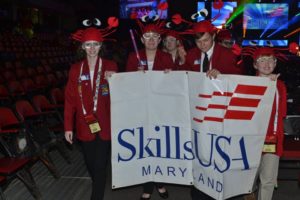
2016 SkillsUSA auto refinishing, collision repair events under way; big changes for auto body welding next year
By onAssociations | Education | Market Trends | Repair Operations | Technology
The future of the collision repair industry might be found in Louisville, Ky., this week as some of the most promising young auto body and painting talent compete in the SkillsUSA Championships.
The interview portion of the collision repair and automotive refinishing was Wednesday morning, running from 8 a.m. to noon at the Kentucky Exposition Center.
Later Wednesday, contestants received a chance to familiarize themselves with the hands-on segment of the competition, which runs Thursday from 8 a.m. to 3:15 p.m.
Winners are announced Friday.
Here’s how SkillsUSA describes the two collision repair competitions:
Collision Repair: “Contestants demonstrate their ability to perform jobs and skills based on the task list outlined by the National Institute for Automotive Service Excellence (ASE) and the National Automotive Technicians Education Foundation (NATEF). The competition includes a series of workstations to assess skills in the following areas: metal straightening, welding, plastic repair and structural analysis. The overall appearance of the finished product, speed and proper safety practices are judged. There are written tests on estimating, structural analysis, and an ASE exam. The students are also interviewed by the judges.”
Automotive Refinishing: “Contestant will demonstrate the ability to perform jobs and skills based on the task list outlined by the National Institute for Automotive Excellence (ASE) and the National Automotive Technicians Education Foundation (NATEF). The competition includes a series of workstations to assess skills in the following areas: surface preparation, spray gun operation, paint mixing, matching and applying, solving paint applications problems, determining finish defects, causes and cures and utilizing safety precautions. The competitor will also complete an interview, a written estimate and an ASE written exam. The overall appearance of the finished products, speed and proper safety practices will be judged.”
Existing painters might be interested in seeing the refinishing tinting study guide, and the MSDS and TDS data sheets, which contains a glimpse at what the high school and technical college students will have to know. (Think of this as your “Are you smarter than a ninth-grader?” moment.
Good luck to all the body and paint competitors — some of which might even encounter a job offer or two while they’re there. And good luck as well to those in the automotive service competition, too. (Have you considered a career in collision repair? We need scanners and calibrators.)
Changes for 2017
Contestants in collision repair who seek to return next year hopefully will take advantage of the opportunities to bone up on the structural analysis and welding changes coming to the 2017 SkillsUSA.
The welding segment will receive a radical overhaul; in fact, it’s being renamed “Attachment Methods” because of the kind of rapid changes happening now in the aftermarket (and factory) joining world.
This year, the welding segment will demonstrate the 15 procedures coming to the 2017 competition, and students had better pay attention. Existing welders should as well, for as I-CAR demonstrated, most of the industry might not know how to do the kind of stuff these kids will next year.
Here’s SkillsUSA’s list of procedures required next year (minor styling edits), taken from this document with descriptions accompanying each item:
- Make a plug weld using aluminum coupons in the vertical position using a GMA (MIG) welder
- Make a butt joint with backing weld using aluminum coupons in the vertical position using a GMA (MIG) welder
- Make a fillet weld on lap using aluminum coupons in the vertical position using a GMA (MIG) welder.
- Make a plug weld using aluminum coupons in the overhead position using a GMA (MIG) welder.
- Make a butt joint with backing weld using aluminum coupons in the overhead position using a GMA (MIG) welder.
- Make a fillet weld on lap using aluminum coupons in the overhead position using a GMA (MIG) welder.
- Make an open butt joint using aluminum coupons in the overhead position using a GMA (MIG) welder.
- Make a squeeze-type resistance spot weld (STRSW) using steel coupons.
- Make a MIG brazing slot weld using steel coupons.
- Make a MIG brazing open butt joint weld using steel coupons.
- Remove and install self‑piercing rivet (SPR).
- Remove and install blind rivet.
- Install solid rivet.
- Install rivet bonded panel.
- Install weld bonded panel.
A display in the structural analysis area will offer a look at how that portion of the SkillsUSA competition will change next year. The difference isn’t entirely clear from SkillsUSA’s description, but we’d guess at least part of it refers to knowing whether and where you can section steel rails growing higher and higher in strength — and thus more susceptible to being compromised by heat or sectioning.
“With the addition of the following to the Computerized Measuring (CRT20.0-20.2) at the 2017 contest,” SkillsUSA wrote. “This section will still have Contestants read and analyze the printouts of Structural misalignment. But, with the addition of looking up information from a hand out, on sectioning of rails and Construction Material of the rail.”
More information:
SkillsUSA contest descriptions
SkillsUSA competition supplements/changes
Featured image: The Maryland delegation is seen during the 2016 SkillsUSA Parade of Champions. (Provided by SkillsUSA)
